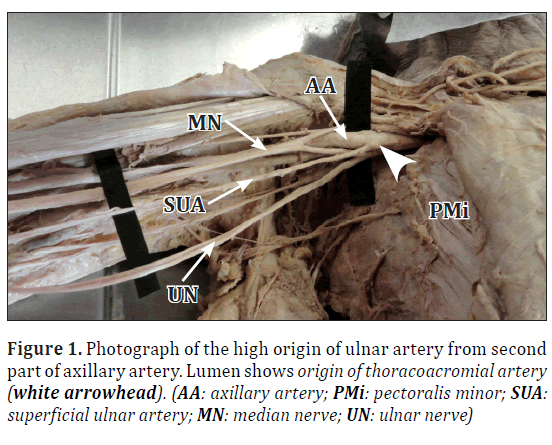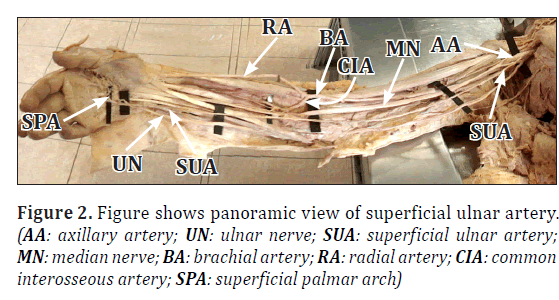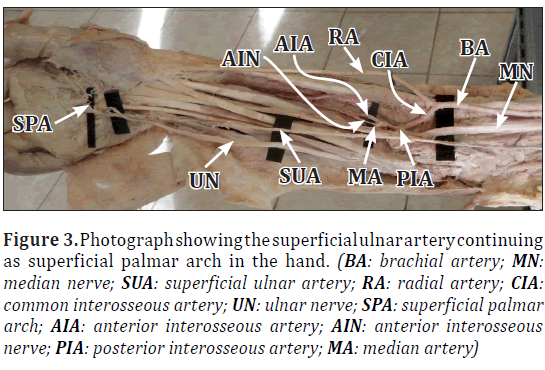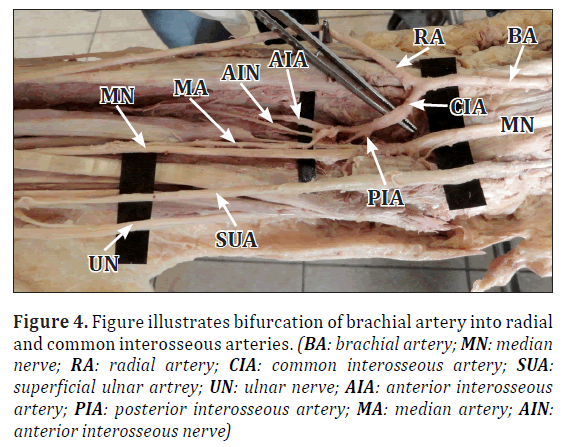Unilateral high origin of ulnar artery with variant bifurcation of brachial artery: a case report
Mitesh R Dave*, Vaishali Kiran Yagain and Samir Anadkat
Department of Anatomy, Medical University of the Americas, Nevis, West Indies
- *Corresponding Author:
- Dr. Mitesh R. Dave
Associate Professor of Anatomy, Medical University of the Americas Potworks, Nevis St.Kitts and Nevis, West Indies
Tel: +1 (869) 764-0727
E-mail: miteshdave30@yahoo.com
Date of Received: June 22nd, 2011
Date of Accepted: July 4th, 2012
Published Online: November 3rd, 2012
© Int J Anat Var (IJAV). 2012; 5: 65–67.
[ft_below_content] =>Keywords
superficial ulnar artery, axillary artery, common interosseous artery, superficial palmar arch
Introduction
Usually the ulnar artery arises as one of the two terminal branches of brachial artery in the cubital fossa, which in turn gives rise to common interosseous artery in the upper forearm. Ulnar artery continues as superficial palmar arch in the hand by joining with superficial palmar branch of radial artery [1]. The term superficial ulnar artery is given when it arises from axillary or brachial arteries and course over superficial muscles of forearm and later joins with ulnar artery or sometimes may replace it [2,3].
Herewith we present a case of unilateral superficial ulnar artery, which originated from the second part of axillary artery and variant termination of brachial artery into radial and common interosseous arteries with its clinical and embryological significance.
Case Report
During routine dissection of the right upper limb of 58-year-old American female cadaver in the Department of Anatomy, Medical University of the Americas, Nevis, West Indies, we found a variant ulnar artery which originated from the second part of axillary artery along with thoracoacromial artery (Figures 1, 2). The origin of the artery was high up above the two roots of median nerve. The ulnar artery was of smaller caliber and it coursed superficially over the flexors of the forearm running lateral to the ulnar nerve throughout its course. Lying medially in the cubital fossa beneath the bicipital aponeurosis, it coursed over the superficial flexors of forearm and finally continued as superficial palmar arch in the hand (Figures 2, 3).
Figure 3: Photograph showing the superficial ulnar artery continuing as superficial palmar arch in the hand. (BA: brachial artery; MN: median nerve; SUA: superficial ulnar artery; RA: radial artery; CIA: common interosseous artery; UN: ulnar nerve; SPA: superficial palmar arch; AIA: anterior interosseous artery; AIN: anterior interosseous nerve; PIA: posterior interosseous artery; MA: median artery)
Brachial artery bifurcated in the cubital fossa at the level of neck of radius into radial and common interosseous arteries. Further, the common interosseous artery divided into anterior and posterior interosseous arteries. Anterior interosseous artery accompanied the anterior interosseous nerve, whereas median artery accompanied the median nerve (Figures 2, 4). Ulnar artery originated and coursed as usual on the left side.
Figure 4: Figure illustrates bifurcation of brachial artery into radial and common interosseous arteries. (BA: brachial artery; MN: median nerve; RA: radial artery; CIA: common interosseous artery; SUA: superficial ulnar artrey; UN: ulnar nerve; AIA: anterior interosseous artery; PIA: posterior interosseous artery; MA: median artery; AIN: anterior interosseous nerve)
Discussion
The superficial ulnar artery is an anatomical variation in the upper limb vasculature. Bilateral superficial ulnar arteries originating from the third part of axillary artery along with subscapular artery was reported by Jacquemin et al. [4]. Similarly, Shankar N et al. reported right ulnar artery originating from the third part of axillary artery and left ulnar artery from the brachial artery [5].
Nakatani et al., and Bhat et al. also reported high origin of ulnar artery from the axillary artery [2,6].
In the present case, we had variant ulnar artery that originated from the second part of axillary artery along with thoracoacromial artery, which is not reported in the literature till now to best of our knowledge. Ulnar artery terminated as usual in hand by forming superficial palmar arch. Brachial artery divided into radial and common interosseous arteries in the cubital fossa (Figures 2, 4). However such variations were absent on the left side.
Embryological basis
In the fetal life, the vascular patterns change as the limb buds develop, chiefly by angiogenesis (sprouting from existing vessels). The primary axis artery becomes the brachial artery in the arm and common interosseous artery in the forearm, which has anterior and posterior interosseous branches. The ulnar and radial arteries are terminal branches of the brachial artery [7]. The developmental changes can be explained on the basis of the persistence of vessels which are normally obliterated, or the disappearance of vessels which are normally retained, or an incomplete development, or sprouts from the axis artery of the developing upper limb bud [8,9]. In the present case, the high origin of ulnar artery may be due to the fact that the ulnar artery sprouted from axis artery in the arm and coursed superficial to the ventral muscle mass of the arm.
Bifurcation of the brachial artery into radial and common interosseous arteries may be correlated with the sprouting of posterior interosseous artery from the axis artery distal to the sprouting of radial artery in the cubital fossa. And, the portion between radial and posterior interosseous arteries becomes common interosseous artery and the remaining part of axis artery becomes anterior interosseous artery.
The knowledge of the anatomical variant of the high origin of ulnar artery is helpful in performing reconstructive surgical procedures for use as microvascular recipient or donor vessel, and its superficial course makes it more accessible to cannulation. Also, the proximal portion of superficial ulnar artery (in the arm) can be harvested for coronary bypass grafts. However, superficial ulnar artery may be injured during intravenous drug administration or percutaneous brachial catheterization, if its presence is not properly diagnosed. This may lead to ischemia of the forearm.
Conclusion
Knowledge of the variant position of the ulnar artery is useful in vascular surgeries of the upper limb, either for use as a microvascular recipient or donor vessel, or to prevent iatrogenic injuries.
Acknowledgements
Our sincere thanks to the faculty members of our university who helped and supported during the writing of this manuscript.
References
- Standring S, ed. Gray’s Anatomy. 39th Ed., Philadelphia, Elsevier, Churchill Livingstone. 2005; 882–929.
- Nakatani T, Tanaka S, Mizukami S, Shiraishi Y, Nakamura T. The superficial ulnar artery originating from the axillary artery. Ann Anat. 1996; 178: 277–279.
- Lippert H, Pabst R. Arterial Variations in Man. Munich, Bergmann. 1985; 66–73.
- Jacquemin G, Lemaire V, Medot M, Fissette J. Bilateral case of superficial ulnar artery originating from axillary artery. Surg Radiol Anat. 2001; 23: 139–143.
- Shankar N, Veeramani R. Bilateral superficial ulnar arteries with an unusual arterial arch in the forearm. Int J Anat Var (IJAV). 2009; 2: 24–26.
- Bhat KM, Potu BK, Gowda S. High origin of ulnar artery in South Indian male cadaver: a case report. Rom J Morphol Embryol. 2008; 49: 573–575.
- Moore KL, Persaud TVN. The Developing Human: Clinically Oriented Embryology. 8th Ed., Philadelphia, Saunders, Elsevier. 2008; 371–372.
- Natsis K, Papadopoulou AL, Paraskevas G, Totlis T, Tsikaras P. High origin of a superficial ulnar artery arising from the axillary artery: anatomy, embryology, clinical significance and a review of the literature. Folia Morphol (Warsz). 2006; 65: 400–405.
- Krishnamurthy A, Kumar M, Nayak SR, Prabhu LV. High origin and superficial course of ulnar artery: a case report. Firat Tip Dergisi. 2006; 11: 66–67.
Mitesh R Dave*, Vaishali Kiran Yagain and Samir Anadkat
Department of Anatomy, Medical University of the Americas, Nevis, West Indies
- *Corresponding Author:
- Dr. Mitesh R. Dave
Associate Professor of Anatomy, Medical University of the Americas Potworks, Nevis St.Kitts and Nevis, West Indies
Tel: +1 (869) 764-0727
E-mail: miteshdave30@yahoo.com
Date of Received: June 22nd, 2011
Date of Accepted: July 4th, 2012
Published Online: November 3rd, 2012
© Int J Anat Var (IJAV). 2012; 5: 65–67.
Abstract
Variations in the vascular system of upper limb are well documented. During routine dissection of the right upper limb of 58-year-old American female cadaver, we observed a high origin of ulnar artery from the second part of axillary artery and the variant bifurcation of the brachial artery into radial and common interosseous arteries. Awareness of these variations is necessary to avoid complications during neurovascular surgery of upper limb, and the superficial position of ulnar artery makes it more vulnerable to trauma and more accessible to cannulation.
-Keywords
superficial ulnar artery, axillary artery, common interosseous artery, superficial palmar arch
Introduction
Usually the ulnar artery arises as one of the two terminal branches of brachial artery in the cubital fossa, which in turn gives rise to common interosseous artery in the upper forearm. Ulnar artery continues as superficial palmar arch in the hand by joining with superficial palmar branch of radial artery [1]. The term superficial ulnar artery is given when it arises from axillary or brachial arteries and course over superficial muscles of forearm and later joins with ulnar artery or sometimes may replace it [2,3].
Herewith we present a case of unilateral superficial ulnar artery, which originated from the second part of axillary artery and variant termination of brachial artery into radial and common interosseous arteries with its clinical and embryological significance.
Case Report
During routine dissection of the right upper limb of 58-year-old American female cadaver in the Department of Anatomy, Medical University of the Americas, Nevis, West Indies, we found a variant ulnar artery which originated from the second part of axillary artery along with thoracoacromial artery (Figures 1, 2). The origin of the artery was high up above the two roots of median nerve. The ulnar artery was of smaller caliber and it coursed superficially over the flexors of the forearm running lateral to the ulnar nerve throughout its course. Lying medially in the cubital fossa beneath the bicipital aponeurosis, it coursed over the superficial flexors of forearm and finally continued as superficial palmar arch in the hand (Figures 2, 3).
Figure 3: Photograph showing the superficial ulnar artery continuing as superficial palmar arch in the hand. (BA: brachial artery; MN: median nerve; SUA: superficial ulnar artery; RA: radial artery; CIA: common interosseous artery; UN: ulnar nerve; SPA: superficial palmar arch; AIA: anterior interosseous artery; AIN: anterior interosseous nerve; PIA: posterior interosseous artery; MA: median artery)
Brachial artery bifurcated in the cubital fossa at the level of neck of radius into radial and common interosseous arteries. Further, the common interosseous artery divided into anterior and posterior interosseous arteries. Anterior interosseous artery accompanied the anterior interosseous nerve, whereas median artery accompanied the median nerve (Figures 2, 4). Ulnar artery originated and coursed as usual on the left side.
Figure 4: Figure illustrates bifurcation of brachial artery into radial and common interosseous arteries. (BA: brachial artery; MN: median nerve; RA: radial artery; CIA: common interosseous artery; SUA: superficial ulnar artrey; UN: ulnar nerve; AIA: anterior interosseous artery; PIA: posterior interosseous artery; MA: median artery; AIN: anterior interosseous nerve)
Discussion
The superficial ulnar artery is an anatomical variation in the upper limb vasculature. Bilateral superficial ulnar arteries originating from the third part of axillary artery along with subscapular artery was reported by Jacquemin et al. [4]. Similarly, Shankar N et al. reported right ulnar artery originating from the third part of axillary artery and left ulnar artery from the brachial artery [5].
Nakatani et al., and Bhat et al. also reported high origin of ulnar artery from the axillary artery [2,6].
In the present case, we had variant ulnar artery that originated from the second part of axillary artery along with thoracoacromial artery, which is not reported in the literature till now to best of our knowledge. Ulnar artery terminated as usual in hand by forming superficial palmar arch. Brachial artery divided into radial and common interosseous arteries in the cubital fossa (Figures 2, 4). However such variations were absent on the left side.
Embryological basis
In the fetal life, the vascular patterns change as the limb buds develop, chiefly by angiogenesis (sprouting from existing vessels). The primary axis artery becomes the brachial artery in the arm and common interosseous artery in the forearm, which has anterior and posterior interosseous branches. The ulnar and radial arteries are terminal branches of the brachial artery [7]. The developmental changes can be explained on the basis of the persistence of vessels which are normally obliterated, or the disappearance of vessels which are normally retained, or an incomplete development, or sprouts from the axis artery of the developing upper limb bud [8,9]. In the present case, the high origin of ulnar artery may be due to the fact that the ulnar artery sprouted from axis artery in the arm and coursed superficial to the ventral muscle mass of the arm.
Bifurcation of the brachial artery into radial and common interosseous arteries may be correlated with the sprouting of posterior interosseous artery from the axis artery distal to the sprouting of radial artery in the cubital fossa. And, the portion between radial and posterior interosseous arteries becomes common interosseous artery and the remaining part of axis artery becomes anterior interosseous artery.
The knowledge of the anatomical variant of the high origin of ulnar artery is helpful in performing reconstructive surgical procedures for use as microvascular recipient or donor vessel, and its superficial course makes it more accessible to cannulation. Also, the proximal portion of superficial ulnar artery (in the arm) can be harvested for coronary bypass grafts. However, superficial ulnar artery may be injured during intravenous drug administration or percutaneous brachial catheterization, if its presence is not properly diagnosed. This may lead to ischemia of the forearm.
Conclusion
Knowledge of the variant position of the ulnar artery is useful in vascular surgeries of the upper limb, either for use as a microvascular recipient or donor vessel, or to prevent iatrogenic injuries.
Acknowledgements
Our sincere thanks to the faculty members of our university who helped and supported during the writing of this manuscript.
References
- Standring S, ed. Gray’s Anatomy. 39th Ed., Philadelphia, Elsevier, Churchill Livingstone. 2005; 882–929.
- Nakatani T, Tanaka S, Mizukami S, Shiraishi Y, Nakamura T. The superficial ulnar artery originating from the axillary artery. Ann Anat. 1996; 178: 277–279.
- Lippert H, Pabst R. Arterial Variations in Man. Munich, Bergmann. 1985; 66–73.
- Jacquemin G, Lemaire V, Medot M, Fissette J. Bilateral case of superficial ulnar artery originating from axillary artery. Surg Radiol Anat. 2001; 23: 139–143.
- Shankar N, Veeramani R. Bilateral superficial ulnar arteries with an unusual arterial arch in the forearm. Int J Anat Var (IJAV). 2009; 2: 24–26.
- Bhat KM, Potu BK, Gowda S. High origin of ulnar artery in South Indian male cadaver: a case report. Rom J Morphol Embryol. 2008; 49: 573–575.
- Moore KL, Persaud TVN. The Developing Human: Clinically Oriented Embryology. 8th Ed., Philadelphia, Saunders, Elsevier. 2008; 371–372.
- Natsis K, Papadopoulou AL, Paraskevas G, Totlis T, Tsikaras P. High origin of a superficial ulnar artery arising from the axillary artery: anatomy, embryology, clinical significance and a review of the literature. Folia Morphol (Warsz). 2006; 65: 400–405.
- Krishnamurthy A, Kumar M, Nayak SR, Prabhu LV. High origin and superficial course of ulnar artery: a case report. Firat Tip Dergisi. 2006; 11: 66–67.










